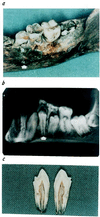Detection of 400-year-old Yersinia pestis DNA in human dental pulp: an approach to the diagnosis of ancient septicemia
- PMID: 9770538
- PMCID: PMC22883
- DOI: 10.1073/pnas.95.21.12637
Detection of 400-year-old Yersinia pestis DNA in human dental pulp: an approach to the diagnosis of ancient septicemia
Abstract
Ancient septicemic plague epidemics were reported to have killed millions of people for 2 millenniums. However, confident diagnosis of ancient septicemia solely on the basis of historical clinical observations is not possible. The lack of suitable infected material has prevented direct demonstration of ancient septicemia; thus, the history of most infections such as plague remains hypothetical. The durability of dental pulp, together with its natural sterility, makes it a suitable material on which to base such research. We hypothesized that it would be a lasting refuge for Yersinia pestis, the plague agent. DNA extracts were made from the dental pulp of 12 unerupted teeth extracted from skeletons excavated from 16th and 18th century French graves of persons thought to have died of plague ("plague teeth") and from 7 ancient negative control teeth. PCRs incorporating ancient DNA extracts and primers specific for the human beta-globin gene demonstrated the absence of inhibitors in these preparations. The incorporation of primers specific for Y. pestis rpoB (the RNA polymerase beta-subunit-encoding gene) and the recognized virulence-associated pla (the plasminogen activator-encoding gene) repeatedly yielded products that had a nucleotide sequence indistinguishable from that of modern day isolates of the bacterium. The specific pla sequence was obtained from 6 of 12 plague skeleton teeth but 0 of 7 negative controls (P < 0.034, Fisher exact test). A nucleic acid-based confirmation of ancient plague was achieved for historically identified victims, and we have confirmed the presence of the disease at the end of 16th century in France. Dental pulp is an attractive target in the quest to determine the etiology of septicemic illnesses detected in ancient corpses. Molecular techniques could be applied to this material to resolve historical outbreaks.
Figures



References
-
- Holden C. Science. 1996;272:1591.
-
- Weiss E. In: Encyclopedia of Microbiology. 1st Ed. Lederberg J, editor. Vol. 3. San Diego: Academic; 1992. pp. 585–610.
MeSH terms
Substances
Associated data
- Actions
LinkOut - more resources
Full Text Sources

